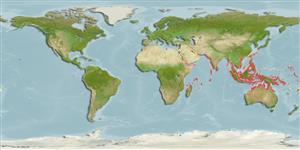Common names from other countries
>
Acanthuriformes (Surgeonfishes) >
Siganidae (Rabbitfishes)
Etymology: Siganus: Latin, siganus = a fish, rabbit fish; by the similarity of the nose (Ref. 45335).
More on author: Linnaeus.
Environment: milieu / climate zone / depth range / distribution range
Ecologie
marien; brak water rifbewoner; oceanodroom (Ref. 51243); diepte 0 - 20 m (Ref. 90102), usually 2 - 20 m (Ref. 27115). Tropical; 25°C - 28°C (Ref. 27115); 30°N - 20°S
Indo-Pacific: Persian Gulf, Gulf of Oman, Pakistan, India, Sri Lanka, Burma, Andaman Islands, Thailand, Viet Nam, southern China, Malaysia, Indonesia, Philippines, Australia, New Guinea, Vanuatu and New Caledonia. Records for the Ryukyu and Ogasawara Islands could be based on strays (Ref. 9813).
Grootte / Gewicht / Leeftijd
Maturity: Lm ? range ? - ? cm
Max length : 53.0 cm TL mannelijk / geslacht onbekend; (Ref. 9710); common length : 30.0 cm TL mannelijk / geslacht onbekend; (Ref. 9813)
Dorsale stekels (totaal) : 13; Dorsale zachte stralen (totaal) : 10; Anale stekels: 7; Anale zachte stralen: 9; Wervels: 13. Body bronze above, white on belly and thorax; iris light brown; pectoral fins hyaline, pelvic fins white. Slender and pungent dorsal spines; anal spines stout. Preopercular angle 78°-92°. Strong scales cover cheeks. Midline of thorax scaled but not pelvic ridges. Broad-based triangular flap of anterior nostril reaching half way to posterior nostril in juveniles, reducing to a small crescent with age.
Occurs in small schools of up to 10 individuals or so, in shallow coastal waters, brackish lagoons and rocky or coral reefs. Feeds on algae attached to the substrate and on floating algal fragments. Found resting in midwater at depths of 2 to 6 m when not feeding. Marketed fresh (Ref. 9813, 48637). Maximum depth from Ref. 027115.
Levenscyclus en paargedrag
Maturities | Voortplanting | Spawnings | Egg(s) | Fecundities | Larven
Woodland, D.J., 1990. Revision of the fish family Siganidae with descriptions of two new species and comments on distribution and biology. Indo-Pac. Fish. (19):136 p. (Ref. 1419)
Status op de Rode Lijst van het IUCN (Ref. 130435)
CITES (Ref. 128078)
Not Evaluated
Gebruik door de mens
Visserij: commercieel; Aquarium: Commercieel
Tools
Speciale rapporten
Download XML
Internetbronnen
Estimates based on models
Preferred temperature (Ref.
115969): 25.5 - 29.1, mean 28.3 (based on 1152 cells).
Fylogenetische diversiteitsindex (Ref.
82804): PD
50 = 0.5000 [Uniqueness, from 0.5 = low to 2.0 = high].
Bayesian length-weight: a=0.01445 (0.00904 - 0.02311), b=3.06 (2.93 - 3.19), in cm Total Length, based on LWR estimates for this species & Genus-body shape (Ref.
93245).
Trofisch niveau (Ref.
69278): 2.4 ±0.08 se; based on food items.
Weerstandsvermogen (Ref.
120179): Gemiddeld, minimale populatieverdubbelingstijd 1,4-4,4 jaar (Preliminary K or Fecundity.).
Fishing Vulnerability (Ref.
59153): Moderate vulnerability (41 of 100).
